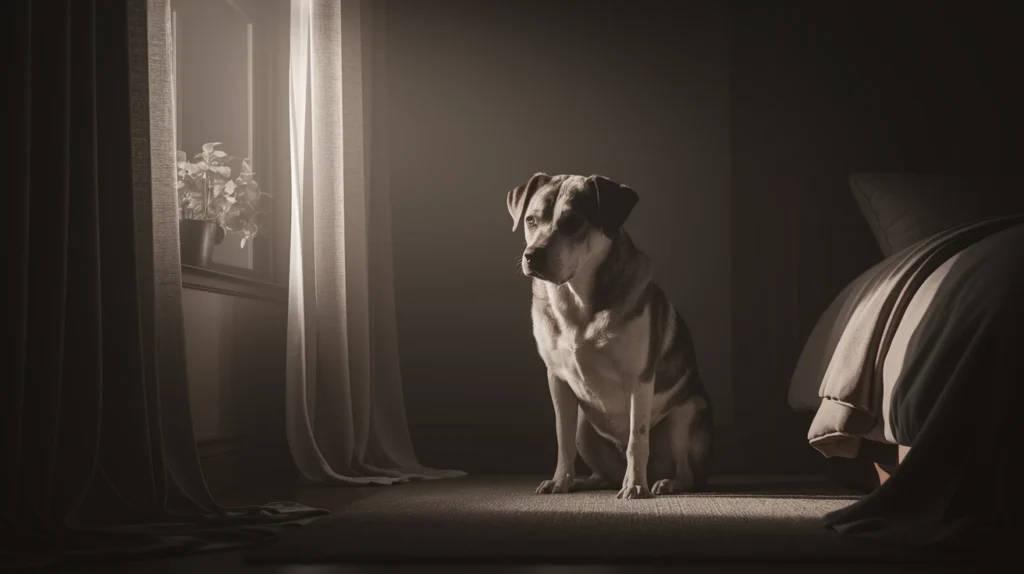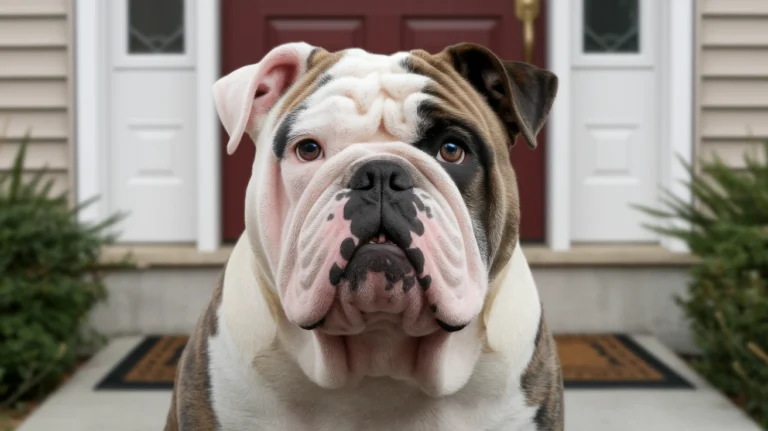Wondering if can dogs have autism? Discover 5 shocking facts about autism-like behaviors in dogs, their causes, and how to support your pet’s unique needs.
Table of Contents

Many pet owners who notice unusual behaviors in their dogs often wonder: can dogs have autism? While humans and dogs share certain neurological similarities, the concept of autism in canines is complex and often misunderstood. As our understanding of animal behavior and neurodiversity evolves, veterinary science has begun exploring behavioral conditions in dogs that may resemble aspects of autism spectrum disorder (ASD) in humans. This comprehensive guide examines the latest research, expert opinions, and observable behaviors that have led some to question whether dogs can experience autism-like conditions. Whether you’re a concerned pet parent noticing repetitive behaviors in your furry friend or a professional seeking to better understand canine behavioral disorders, this article provides valuable insights into this fascinating and emerging area of veterinary behavioral science.
Understanding Autism in Humans vs. Dogs
What Is Autism in Humans?
Autism Spectrum Disorder (ASD) in humans is a complex neurodevelopmental condition characterized by challenges with social skills, repetitive behaviors, speech, and nonverbal communication. It’s considered a spectrum because it affects individuals differently and to varying degrees. Key characteristics include:
- Difficulties with social interaction and communication
- Repetitive behaviors and restricted interests
- Sensory sensitivities (over or under-responsiveness to stimuli)
- Preference for routine and resistance to change
- Varying levels of intellectual abilities
Autism in humans is diagnosed through behavioral evaluations, developmental assessments, and standardized screening tools. The condition is believed to result from a combination of genetic and environmental factors affecting early brain development.
The Controversial Concept of Canine Autism
When discussing whether dogs can have autism, it’s important to understand that veterinary medicine does not officially recognize “canine autism” as a clinical diagnosis. Dogs cannot be diagnosed with autism in the same way humans can. However, researchers and veterinary behaviorists have observed behavioral patterns in some dogs that share similarities with certain autism-like characteristics.
Dr. Nicholas Dodman, Professor Emeritus at Tufts University’s Cummings School of Veterinary Medicine, has conducted research on bull terriers showing repetitive tail-chasing behaviors and has proposed that these behaviors might represent a type of autism-like condition in dogs. His studies have identified genetic markers in these dogs that overlap with those found in humans with autism.
Rather than using the term “autism,” veterinarians typically refer to these behavioral differences as:
- Canine Dysfunctional Behavior (CDB)
- Canine Compulsive Disorder (CCD)
- Stereotypic behaviors
- Tail-chasing syndrome
These terms more accurately reflect what we currently understand about these behaviors in dogs without inappropriately applying human diagnostic categories to canines.
Fact #1: Dogs Can Display Behaviors Similar to Autism Symptoms
Observable Autism-Like Behaviors in Dogs
While dogs cannot be diagnosed with autism per se, they can exhibit behaviors that resemble certain aspects of ASD in humans. These behaviors might include:
- Social interaction difficulties: Some dogs show limited interest in socializing with other dogs or humans, avoiding eye contact, or displaying inappropriate social responses.
- Repetitive behaviors: Tail chasing, spinning in circles, excessive licking, or fixating on particular objects may resemble the repetitive behaviors seen in autism.
- Unusual reactions to sensory stimuli: Heightened sensitivity or unusual responses to certain sounds, textures, or visual stimuli can occur in some dogs.
- Inflexible adherence to routines: Extreme distress when routines are changed or unusual attachment to specific toys or objects.
- Communication differences: Difficulty understanding or responding to common commands or social cues from humans or other dogs.
Case Example: Shadow’s Story
Shadow, a 3-year-old Border Collie, displayed several behaviors that concerned his owners enough to consult with a veterinary behaviorist. Shadow showed minimal interest in playing with other dogs, performed repetitive spinning behaviors when stressed, became extremely distressed by certain sounds like vacuum cleaners, and would only eat from a specific bowl placed in a specific location. After ruling out medical causes, the veterinary behaviorist identified these as behavioral issues that shared some similarities with autism-like symptoms but diagnosed Shadow with Canine Compulsive Disorder rather than “canine autism.”
Breed Predispositions
Some research suggests certain breeds may be more predisposed to autism-like behaviors than others:
| Breed | Common Autism-Like Behaviors | Research Notes |
| Bull Terriers | Tail chasing, spinning, obsessive behaviors | Most studied breed for potential autism-like conditions |
| German Shepherds | Fixed focus, repetitive behaviors | Higher incidence of obsessive-compulsive behaviors |
| Border Collies | Fixations, sound sensitivities | Breed predisposition to developing compulsive behaviors |
| Doberman Pinschers | Flank-sucking, blanket-sucking | Genetically linked compulsive behaviors |
| Jack Russell Terriers | Persistent digging, chasing shadows | High energy often mistaken for compulsive behavior |
It’s crucial to note that these predispositions don’t mean these breeds have autism or that every dog in these breeds will display these behaviors. Environmental factors, training, socialization, and individual differences play significant roles in behavioral development.
Fact #2: The Scientific Research on Canine Behavioral Disorders Is Still Emerging
Current Research Status
The scientific understanding of autism-like conditions in dogs is still in its early stages. Unlike human autism research, which has decades of clinical studies and established diagnostic criteria, canine behavioral research in this area is relatively new.
Key research developments include:
- Genetic studies: Researchers at Tufts University identified genetic markers in tail-chasing bull terriers that have some overlap with genes associated with autism in humans. A 2014 study published in the Journal of the American Veterinary Medical Association found that bull terriers with repetitive tail-chasing behavior had elevated blood levels of neurotensin and corticotropin-releasing hormone—two peptides also elevated in some humans with autism.
- Brain imaging research: Limited but growing research using MRI to study brain differences in dogs with compulsive behaviors shows some patterns similar to those seen in humans with OCD and autism.
- Behavioral assessments: Several research institutions are developing standardized assessments to better categorize and understand unusual social behaviors in dogs.
- Translational research: Some researchers are studying whether insights from canine behavioral disorders might help understand human conditions like autism, and vice versa.
Limitations of Current Research
Despite these promising developments, the research has significant limitations:
- Small sample sizes in most studies
- Difficulty controlling for environmental variables
- Challenges in objectively measuring canine social behavior
- Risk of anthropomorphizing (attributing human characteristics to animals)
- Limited funding compared to human autism research
Dr. Melissa Bain, Professor of Clinical Animal Behavior at the University of California, Davis, cautions: “While there are interesting parallels between some canine behaviors and human autism characteristics, we must be careful not to oversimplify or draw direct equivalencies. Dogs have their own unique behavioral patterns and social structures that differ from humans.”
What Experts Say
Veterinary behaviorists and animal cognition experts have varying perspectives on whether dogs can have autism:
- Dr. Karen Overall, veterinary behaviorist and researcher: “What we’re seeing in some dogs are behavioral patterns that share features with human conditions, but the underlying neurobiology may be quite different. We should be cautious about using human diagnostic terms for dogs.”
- Dr. Temple Grandin, animal behavior expert and autism advocate: “Animals can definitely have behavioral differences and sensory sensitivities similar to those seen in autism. I’ve observed behaviors in some animals that remind me of my own autistic experiences.”
- Dr. Jessica Hekman, veterinary genetics researcher: “There’s growing evidence for genetic influences on compulsive behaviors in dogs that may share some pathways with human neurological conditions, but we’re still far from understanding the full picture.”
The consensus among most experts is that while dogs can exhibit behaviors that resemble certain aspects of autism, applying the human diagnostic label of “autism” to dogs is problematic and potentially misleading.
Fact #3: Distinguishing Between Autism-Like Behaviors and Other Conditions Is Crucial
Common Misinterpretations
Many behaviors that might appear “autism-like” to dog owners actually have other explanations:
- Medical conditions: Neurological problems, pain, thyroid disorders, or sensory deficits can cause unusual behaviors that might be misinterpreted as autism-like symptoms.
- Normal breed characteristics: Some breeds naturally show less interest in social interaction or have high energy and focus that might be misinterpreted as obsessive behavior.
- Inadequate socialization: Dogs with limited early exposure to other dogs, people, or environments may develop social difficulties that resemble autism-like behaviors.
- Fear and anxiety: Many repetitive behaviors are actually anxiety-related coping mechanisms rather than neurological differences.
- Aging-related cognitive changes: Older dogs may develop behaviors that appear similar to autism symptoms due to cognitive decline.
Differential Diagnosis: Conditions That May Mimic Autism-Like Behaviors
When evaluating a dog with behaviors that seem autism-like, veterinarians typically consider these alternative diagnoses:
| Condition | Similar Behaviors | Distinguishing Features |
| Canine Compulsive Disorder | Repetitive behaviors, fixations | Usually triggered by stress, can often be interrupted |
| Noise Phobia | Sensory sensitivities, hiding | Specifically triggered by sounds |
| Generalized Anxiety | Avoidance, repetitive behaviors | Broader pattern of anxious responses |
| Cognitive Dysfunction Syndrome | Disorientation, reduced social interaction | Progressive, age-related, affects memory |
| Pain-related behavior | Withdrawal, irritability | Evidence of physical discomfort, often improves with pain management |
| Seizure Disorders | Staring, repetitive movements | Episodic nature, possible loss of consciousness |
Proper veterinary assessment is essential before assuming a dog has an autism-like condition. Dr. Christopher Pachel, board-certified veterinary behaviorist, emphasizes: “A comprehensive medical evaluation is the crucial first step when a dog shows behavioral changes. We need to rule out medical causes before considering behavioral diagnoses.”
The Diagnostic Process
When a dog shows behaviors that might resemble autism, a thorough diagnostic process typically involves:
- Complete medical examination: Including blood work, neurological examination, and sometimes advanced imaging
- Behavioral history: Detailed information about when behaviors started, what triggers them, how they’ve changed over time
- Direct observation: Professional assessment of the dog’s behavior in different contexts
- Rule-out process: Systematically eliminating other potential causes
- Consultation with specialists: Often involving both veterinary behaviorists and neurologists
This process helps ensure that dogs receive appropriate treatment for their specific condition rather than being mislabeled with a human diagnostic category.
Fact #4: Management Approaches Similar to Human Autism Interventions Can Help Some Dogs
Effective Management Strategies
While there’s no “cure” for autism-like behaviors in dogs, many of the approaches used to help humans with autism can be adapted to improve the quality of life for dogs with similar behavioral patterns:
- Environmental modifications: Creating predictable routines and safe spaces where the dog can retreat when overwhelmed.
- Behavior modification: Using positive reinforcement techniques to gradually expand the dog’s comfort zone and reduce problematic behaviors.
- Sensory accommodations: Identifying and minimizing exposure to triggers that cause distress, such as certain sounds or textures.
- Enrichment activities: Providing appropriate mental stimulation through food puzzles, scent work, or structured play that accommodates the dog’s preferences.
- Socialization at the dog’s pace: Carefully managed exposure to other dogs and people with positive associations.
- Medication: In some cases, veterinarians may prescribe medications to help manage anxiety, compulsive behaviors, or other symptoms.
Sam’s Success Story
Sam, a 4-year-old Australian Shepherd, displayed minimal interest in social interaction, became extremely distressed by changes to his routine, and engaged in repetitive paw licking that caused skin damage. His owners worked with a veterinary behaviorist to create a comprehensive management plan.
By establishing a consistent daily schedule, creating a quiet “safe room” where Sam could retreat when overwhelmed, using positive reinforcement training, and implementing appropriate medication, Sam’s owners saw significant improvements in his quality of life. While his underlying behavioral tendencies didn’t disappear completely, his distress levels decreased substantially, and his repetitive behaviors reduced by approximately 80% over six months.
The Role of Training and Environment
Training approaches for dogs with autism-like behaviors often differ from traditional dog training methods:
- Shorter training sessions to accommodate potentially limited attention spans
- Consistent, clear cues using the communication method that works best for the individual dog
- Predictable consequences to build confidence and reduce anxiety
- Emphasis on positive reinforcement rather than correction-based methods
- Accommodation of sensory needs while gradually expanding tolerance
Dr. Ilana Reisner, veterinary behaviorist, notes: “The environment we create for these dogs is crucial. Just as with humans on the autism spectrum, creating an environment that accommodates their needs while gently expanding their capabilities can make an enormous difference.”
Fact #5: Early Recognition and Intervention Can Significantly Improve Outcomes
Warning Signs to Watch For
Early identification of potential autism-like behaviors can lead to more effective management. Dog owners should be aware of these potential warning signs:
- Minimal eye contact or interest in social interaction from puppyhood
- Extreme distress when routines change
- Unusual sensory sensitivities (over-reacting or under-reacting to stimuli)
- Repetitive behaviors that are difficult to interrupt
- Failure to develop normal play behaviors
- Unusual movements like spinning or rocking
- Fixation on particular objects or activities
- Difficulty adapting to new environments
It’s important to note that many puppies show some of these behaviors temporarily as part of normal development. Concerns arise when these behaviors persist, intensify over time, or significantly impact the dog’s quality of life.
The Importance of Early Intervention
Research in both human and veterinary behavior suggests that early intervention for behavioral differences can have significant benefits:
- Prevention of behavior reinforcement: Early intervention can prevent repetitive behaviors from becoming deeply ingrained habits.
- Neural plasticity: Younger brains have greater adaptability, potentially allowing for more successful behavior modification.
- Prevention of secondary problems: Early management can prevent complications like anxiety disorders that often develop alongside untreated behavioral issues.
- More positive socialization experiences: Earlier intervention allows for more carefully managed positive experiences during critical developmental periods.
A 2019 study published in the Journal of Veterinary Behavior found that dogs who received behavioral intervention for compulsive behaviors before one year of age showed significantly better long-term outcomes than those whose treatment began after two years of age.
When to Consult a Professional
Dog owners should consider consulting a veterinarian or veterinary behaviorist if they observe:
- Behaviors that seem unusual compared to other dogs of the same breed and age
- Repetitive behaviors that the dog can’t easily stop
- Signs of distress without obvious causes
- Social difficulties that seem beyond typical shyness
- Any concerning behavior that persists for more than a few weeks
Early consultation doesn’t necessarily mean something is seriously wrong—it simply provides the opportunity for expert assessment and guidance before problems potentially escalate.
Supporting Dogs with Behavioral Differences
Creating a Supportive Home Environment
Dogs with autism-like behaviors often thrive in environments that provide:
- Predictability: Consistent daily routines help these dogs feel secure.
- Appropriate sensory management: Identifying and minimizing exposure to triggers that cause distress.
- Safe spaces: Designated quiet areas where the dog can retreat when feeling overwhelmed.
- Clear communication: Consistent cues and consequences that the dog can understand.
- Appropriate exercise: Physical activity tailored to the individual dog’s needs and preferences.
- Mental stimulation: Enrichment activities that engage the dog’s mind without causing frustration.
- Patience and acceptance: Understanding that the dog may always have certain differences and needs.
The Role of Diet and Supplements
While research specifically on dietary interventions for autism-like conditions in dogs is limited, some veterinary specialists have observed potential benefits from certain approaches:
- Food sensitivities: Some dogs show behavioral improvements when potential food sensitivities are identified and eliminated.
- Omega-3 fatty acids: These have shown some promise for supporting brain health and potentially reducing certain repetitive behaviors.
- Probiotics: Emerging research on the gut-brain connection suggests potential benefits of probiotic supplementation for some behavioral issues.
Dr. Jean Dodds, veterinary nutritionist, suggests: “While we don’t have definitive evidence for dietary interventions specifically for autism-like behaviors in dogs, addressing overall nutritional health, potential food sensitivities, and gut health may support better behavior and brain function in some cases.”
It’s important to note that any dietary changes or supplements should be discussed with a veterinarian, as inappropriate supplementation can potentially cause harm.
Working with Veterinary Professionals
The most effective approach to supporting dogs with autism-like behaviors involves collaboration between owners and professionals:
- Regular veterinary care: Ongoing monitoring to ensure behavior changes aren’t related to developing medical conditions.
- Veterinary behaviorist consultation: These specialists have advanced training in both veterinary medicine and behavior.
- Professional trainer input: Trainers experienced with special needs dogs can provide valuable guidance.
- Possible interdisciplinary approach: Some cases benefit from input from veterinary neurologists, nutritionists, and other specialists.
When seeking professional help, owners should look for providers who:
- Have experience with developmental and compulsive disorders in dogs
- Use evidence-based, humane approaches
- Emphasize positive reinforcement methods
- Consider the whole dog, including physical health, emotional well-being, and quality of life
Frequently Asked Questions About Autism-Like Behaviors in Dogs
Can puppies be born with autism?
Dogs cannot be diagnosed with autism as it’s defined in humans. However, some puppies may be born with neurological differences that result in behaviors resembling certain aspects of autism. These differences might be genetic or related to factors during prenatal development. Early signs might include unusual social interactions, sensory sensitivities, or repetitive behaviors that persist beyond the typical puppy stage.
How do I know if my dog has autism or is just shy?
Normal shyness in dogs typically improves with gentle exposure and positive experiences. Dogs with more significant developmental differences often show a cluster of unusual behaviors beyond just shyness, including repetitive movements, extreme routine dependence, unusual sensory responses, and difficulties with typical dog communication. A veterinary behaviorist can help distinguish between normal shyness and more complex behavioral differences.
Can dogs develop autism-like behaviors after a traumatic event?
Trauma can certainly cause behavioral changes in dogs that might superficially resemble some autism-like symptoms, particularly withdrawal from social interaction and heightened sensitivity to environmental stimuli. However, these would typically be classified as post-traumatic stress responses rather than developmental differences. The treatment approaches may share some similarities but would address the specific trauma history.
Are autism-like behaviors in dogs treatable?
While there’s no “cure” for developmental differences in dogs, many of the associated challenges can be effectively managed through a combination of environmental modifications, behavioral training, and sometimes medication. Most dogs with these behavioral differences can lead happy, fulfilling lives when their needs are understood and accommodated appropriately. The focus should be on maximizing quality of life rather than eliminating all differences.
Can vaccines cause autism in dogs?
There is absolutely no scientific evidence supporting the claim that vaccines cause autism-like behaviors in dogs. Multiple large-scale studies in humans have definitively disproven the vaccine-autism link, and there is no evidence suggesting such a link in dogs either. Proper vaccination remains an essential part of responsible dog care. Any behavioral changes noted after vaccination should be discussed with a veterinarian but are more likely related to other factors or coincidental timing.
Do dogs with autism-like behaviors do better with other animals?
This varies greatly by individual. Some dogs with social difficulties may find other animals stressful, while others may form strong bonds with certain companion animals. Some dogs may be more comfortable with calm, predictable animals than with humans. Careful introduction and monitoring are important when introducing any new animal to a household with a behaviorally sensitive dog.
Can dogs with autism-like symptoms live normal lives?
Absolutely. With appropriate understanding, accommodation, and support, dogs with behavioral differences can live happy, fulfilling lives. The key is to understand and work with the individual dog’s needs and strengths rather than trying to force them into “typical” dog behaviors or expectations. Many owners of dogs with these special needs report deeply rewarding relationships with their unique canine companions.
Call-to-Action
Understanding our dogs’ unique behavioral needs is essential for providing them with the best possible care and quality of life. If you’ve observed behaviors in your dog that concern you or resemble some of the autism-like characteristics described in this article, consider consulting with a veterinary professional who specializes in behavior. Early intervention and appropriate management can make a tremendous difference.
For more expert pet care tips, in-depth guides on canine behavior, and advice tailored to your dog’s specific needs, visit BlithePet. Our team of veterinary experts and animal behaviorists provides research-backed information to help you navigate the complexities of pet parenthood with confidence.
Conclusion can dogs have autism
While dogs cannot be diagnosed with autism as it’s defined in humans, some dogs do exhibit behavioral patterns that share similarities with certain aspects of autism spectrum disorder. The emerging research in this area suggests complex genetic and neurological factors may contribute to these behavioral differences in dogs.
For dog owners navigating these challenges, the most important takeaways are:
- Proper veterinary assessment is essential to rule out medical causes for unusual behaviors
- Early intervention often leads to better outcomes
- Management approaches that accommodate the dog’s unique sensory and social needs can significantly improve quality of life
- With understanding and appropriate support, dogs with behavioral differences can thrive
The science of canine behavior continues to evolve, offering new insights and approaches to supporting dogs with special behavioral needs. By maintaining an open mind while grounding our understanding in scientific evidence rather than assumptions, we can better serve our canine companions with developmental differences.
Have you noticed unusual behaviors in your dog that resemble some of the characteristics discussed in this article? Share your experiences in the comments below. Your insights might help other pet parents navigating similar situations with their furry family members.







